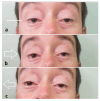Syndromic Retinitis Pigmentosa: A 15-Patient Study
- PMID: 38674450
- PMCID: PMC11050127
- DOI: 10.3390/genes15040516
Syndromic Retinitis Pigmentosa: A 15-Patient Study
Abstract
Retinitis pigmentosa is a group of genetically determined retinal dystrophies characterized by primary photoreceptor apoptosis and can occur in isolated or syndromic conditions. This study reviewed the clinical data of 15 patients with syndromic retinitis pigmentosa from a Rare Disease Reference Center in Brazil and the results of their next-generation sequencing tests. Five males and ten females participated, with the mean ages for ocular disease onset, fundoscopic diagnosis, and molecular evaluation being 9, 19, and 29 years, respectively. Bardet-Biedl syndrome (n = 5) and Usher syndrome (n = 3) were the most frequent diagnoses, followed by other rare conditions. Among the patients, fourteen completed molecular studies, with three negative results and eleven revealing findings in known genes, including novel variants in MKKS (c.432_435del, p.Phe144Leufs*14), USH2A (c.(7301+1_7302-1)_(9369+1_9370-1)del), and CEP250 (c.5383dup, p.Glu1795Glyfs*13, and c.5050del, p.Asp1684Thrfs*9). Except for Kearn-Sayre, all presented an autosomal recessive inheritance pattern with 64% homozygosity results. The long gap between symptom onset and diagnosis highlights the diagnostic challenges faced by the patients. This study reaffirms the clinical heterogeneity of syndromic retinitis pigmentosa and underscores the pivotal role of molecular analysis in advancing our understanding of these diseases.
Keywords: Bardet–Biedl syndrome; Usher syndrome; genetic testing; molecular diagnoses; precision medicine; retinitis pigmentosa.
Conflict of interest statement
The authors declare no conflicts of interests.
Figures


References
-
- Dias M.F., Joo K., Kemp J.A., Fialho S.L., da Silva Cunha A., Jr., Woo S.J., Kwon Y.J. Molecular genetics and emerging therapies for retinitis pigmentosa: Basic research and clinical perspectives. Prog. Retin. Eye Res. 2018;63:107–131. doi: 10.1016/j.preteyeres.2017.10.004. Erratum in Prog. Retin. Eye Res. 2018, 66, 220–221. - DOI - PubMed
-
- Salmon J.F., Bowling B. Hereditary fundus dystrophies. In: Saunders W.B., editor. Kanski’s Clinical Ophthalmology. 8th ed. Elsevier; Amsterdam, The Netherlands: 2020. pp. 619–631.
Publication types
MeSH terms
LinkOut - more resources
Full Text Sources
Miscellaneous

